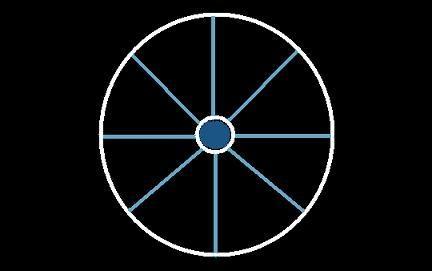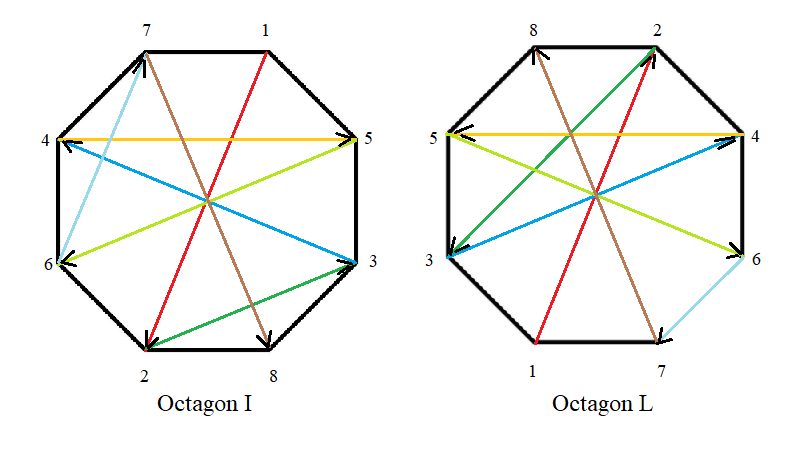Octagon Algorithm for Border Wheel Squares (Part XI)
The Eight Node Way - (1,4,7) Squares
The previous sections Part X introduced the Octagon I and K algorithm for the construction of 5×5 thru 11×11 Wheel Border Squares (WBS). The type of Wheel Border squares in Part IX was of the type (a,b,e). This section will look at WBS are of the type (a,d,f) where a and is 1, d is 4 and e is 7, i.e., the start of each wheel spoke is (1,4,7). This part will introduce a new algorithm Octagon L along with Octagon I will be used to generate Border squares by the use of consecutive numbers (c,d,r) as the last cells in the central, diagonal and row spokes adjacent to the center cell in the square.
It will be shown that c, d and r can take on certain values only, as shown in Table I for the 5th order square case Wheel 5(0), with c originally odd or even. We have to decide what consecutive three numbers to place into the empty cells so that each row, column and diagonal of the central 3×3 square sums to 39. The numbers 8, 9 and 10 fit the description since they are not present as numbers in the other spoke cells. It is also shown to be the only triplet in Table I having the requisite properties, since all the odd and the rest of the even triplets have at least one number in common with a number in every spoke of the wheel:
Table I
| Odd c | Even c |
| 1,2,3 | 2,3,4 |
| 3,4,5 | 4,5,6 |
| 5,6,7 | 6,7,8 |
| 7,8,9 | 8,9,10 |
| 9,10,11 | 10,11,12 |
|
| |
Wheel 5(0)
| 22 | |
1 | |
15 |
| 17 |
| 14 |
|
| 7 | |
13 | 16 |
19 |
| 12 |
18 | |
|
| 11 | |
25 | |
4 |
|
Moreover, the triplet (8,9,10) ensures that the upper part of the complementary Table II allows for the two pair (even parity) of adjacent numbers (2,3) and (5,6) to be available for for insertion into the square. The rule is that numbers that are not paired up (odd parity) will not produce Wheel magic squares. :
Table II
| 1 | 2 | 3 |
4 | 5 | 6 |
7 | 8 |
9 | 10 |
11 | 12 |
We can thus summarize that 4n+1 odd order squares (5,9,13...) use the even c and the 4n+3 order squares (3,7,11...) use the odd c. This is due to the fact that the last numbers to be included in a triplet are even for the 4n+1 and odd for the 4n+3. What this means as shown in Table I is that the number one will always be unpaired when c is even but not when c is odd as in Table IV for a 7th order square.
Table IIIa
| Odd c |
| 1,2,3 |
| 3,4,5 |
| 5,6,7 |
| 7,8,9 |
| 9,10,11 |
| 11,12,13 |
|
| |
Table IIIb
| Odd c |
| 13,14,15 |
| 15,16,17 |
| 17,18,19 |
| 19,20,21 |
| 21,22,23 |
|
| |
Table IV
| 1 | 2 | 3 |
4 | 5 | 6 |
7 | 8 | 9 |
10 | 11 | 12 | 13 |
14 | 15 |
16 | 17 | 18 | 19 | 20 | 21 |
| | | |
| | |
| | | | | |
|
15 | 16 |
17 | | | | |
| | | | | |
|
| | | | | |
|
| | 17 | 18 |
19 | | |
| | | | | |
|
| | | | | |
| | | | | 19 |
20 | 21 |
|
The numbers after the main diagonal is filled run in the order 1 (top center), 4 (bottom right) and 7 (left center). A difference (Δ) of 7 is then added to each of the numbers followed by either of the three triplets in Table IIIb since all the other triplets will have a number common with those already in the spokes (see Border 5(15,16,17), Border 5(17,18,19 and Border 5(19,20,21) fully developed squares below). But before that the wheel portion of the square is filled according to Part X, using the blue color values from Table IIIb. This ensures that in the internal 3×3 square every row, column and diagonal adds up to the magic sum of 75. The second part of the process is addition of the non spoke cells employing the following two algorithms, which use graph theory, as was done previously in Part X.
Final construction of the squares involve employing the Octagon I algorithm for the blue color cells and the L algorithm for the green color cells.
Border 5(8,9,10)l
| 22 | 24 |
1 | 3 |
15 |
| 20 | 17 |
8 | 14 |
6 |
| 7 | 10 |
13 | 16 |
19 |
| 5 | 12 |
18 | 9 |
21 |
| 11 | 2 |
25 | 23 |
4 |
|
|
Border 7(15,16,17)il
| 46 | 47 |
41 | 1 |
10 | 2 |
28 |
| 6 | 39 |
32 | 8 |
19 | 27 | 44 |
| 37 | 29 |
34 | 15 |
26 | 21 | 13 |
| 7 | 14 |
17 | 25 |
33 | 36 |
43 |
| 12 | 20 |
24 | 35 |
16 | 30 | 38 |
| 45 | 23 |
18 | 42 |
31 | 11 | 5 |
| 22 | 3 |
9 | 49 |
40 | 48 | 4 |
|
|
Border 7(17,18,19)il
| 46 | 47 |
41 | 1 |
10 | 2 |
28 |
| 6 | 39 |
35 | 8 |
16 | 27 | 44 |
| 37 | 29 |
32 | 17 |
26 | 21 | 13 |
| 7 | 14 |
19 | 25 |
31 | 36 |
43 |
| 12 | 20 |
24 | 33 |
18 | 30 | 38 |
| 45 | 23 |
15 | 42 |
34 | 11 | 5 |
| 22 | 3 |
9 | 49 |
40 | 48 | 4 |
|
|
Border 7(19,20,21)il
| 46 | 47 |
41 | 1 |
10 | 2 |
28 |
| 6 | 39 |
35 | 8 |
16 | 27 | 44 |
| 37 | 32 |
30 | 19 |
26 | 18 | 13 |
| 7 | 14 |
21 | 25 |
29 | 36 |
43 |
| 12 | 17 |
24 | 31 |
20 | 33 | 38 |
| 45 | 23 |
15 | 42 |
34 | 11 | 5 |
| 22 | 3 |
9 | 49 |
40 | 48 | 4 |
|
If we shift all the initial numbers over by two, first once and then twice the two squares 7a and 7b are obtained using table IIIb to fill in the internal squares with the sums=75. Only two of the entries in Table IIIb are possible since the entry (15,16,17), employed above, contains the number 16, a number already present in the center row. Only two squares of 7b, the (17,18,19) and the (19,20,21) are possible and only the one for 7c.
Table IIIb
| Odd c |
| 13,14,15 |
| 15,16,17 |
| 17,18,19 |
| 19,20,21 |
| 21,22,23 |
|
| |
Border 7b(17,18,19)il
| 44 | 48 |
43 | 3 |
8 | 1 |
28 |
| 5 | 37 |
36 | 10 |
15 | 27 | 45 |
| 38 | 29 |
32 | 17 |
26 | 21 | 12 |
| 9 | 16 |
19 | 25 |
31 | 34 |
41 |
| 11 | 20 |
24 | 33 |
18 | 30 | 39 |
| 46 | 23 |
14 | 40 |
35 | 13 | 4 |
| 22 | 2 |
7 | 47 |
42 | 49 | 6 |
|
|
Border 7b(19,20,21)il
| 44 | 48 |
43 | 3 |
8 | 1 |
28 |
| 5 | 37 |
36 | 10 |
15 | 27 | 45 |
| 38 | 32 |
30 | 19 |
26 | 18 | 12 |
| 9 | 16 |
21 | 25 |
29 | 34 |
41 |
| 11 | 17 |
24 | 31 |
20 | 33 | 39 |
| 46 | 23 |
14 | 40 |
35 | 13 | 4 |
| 22 | 2 |
7 | 47 |
42 | 49 | 6 |
|
|
Border 7c(19,20,21)il
| 42 | 44 |
48 | 5 |
7 | 1 |
28 |
| 4 | 35 |
37 | 12 |
14 | 27 | 46 |
| 40 | 33 |
30 | 19 |
26 | 17 | 10 |
| 11 | 18 |
21 | 25 |
29 | 32 |
39 |
| 9 | 16 |
24 | 31 |
20 | 34 | 41 |
| 47 | 23 |
13 | 38 |
36 | 15 | 3 |
| 22 | 6 |
2 | 45 |
43 | 49 | 8 |
|
This completes the Octagon I and L method. Go to Part XII.
Go back to Part IX. Go back to homepage.
Copyright © 2022 by Eddie N Gutierrez. E-Mail: enaguti1949@gmail.com


